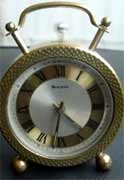- Most Women Aren’t Clear When Menopause Might Start
- New Visual Test For Autism Could Aid Earlier Diagnosis
- Half-Million Children Could Die If U.S. AIDS Relief Is Dropped
- Seasonal Allergies Likely To Grow Worse Under Climate Change
- First Baby Born From Robot-Controlled IVF
- Eviction Bans Linked To Drop In Child Abuse Reports
- Bausch + Lomb Issues Recall of enVista Lenses Used in Cataract Surgery
- Pets May Boost Happiness As Much As Family or Friends
- A New UV Light May Help Stop Future Pandemics
- FDA Reverses Office Order, Lets Staff Work From Home
‘Body Clock’ May Explain Why Some Body Parts Age Faster Than Others


MONDAY, Oct. 21Scientists who say they discovered a “body clock” that can reveal the biological age of most human tissues suggest that their findings may help shed light on why people’s bodies age and how to slow the process.
Their results also provide important insights into cancer and stem cell research, the researchers said.
“To fight aging, we first need an objective way of measuring it,” Steve Horvath, a professor of human genetics and of biostatistics at the University of California, Los Angeles, said in a university news release. “Pinpointing a set of biomarkers that keeps time throughout the body has been a four-year challenge.”
“I’ve pursued this clock to help improve understanding of what speeds up and slows down the aging process,” Horvath said.
Horvath and his team are believed to be the first to identify a mechanism in the body that enables scientists to measure accurately the biological age of different tissues, organs and cell types. Using this newly discovered biological clock, the researchers said they were surprised to find that some parts of the body, such as a woman’s breast tissue, appear to age faster than the rest of the body.
“Healthy breast tissue is about two to three years older than the rest of a woman’s body,” Horvath said. “If a woman has breast cancer, the healthy tissue next to the tumor is an average of 12 years older than the rest of her body.”
The results may explain why breast cancer is the most common cancer in women, according to the news release.
The researchers also found that the biological clock ranked tumor tissue an average of 36 years older than healthy tissue, which could explain why age is a major risk factor for many cancers in both women and men.
For his research, Horvath focused on methylation, a naturally occurring process that alters DNA. Using nearly 8,000 samples of 51 tissue types and cells taken from throughout the body, he charted how age affects DNA methylation levels from before birth through age 101.
Horvath tested the bio clock’s effectiveness by comparing a tissue’s biological age to its chronological age and found that the clock repeatedly proved accurate.
“It’s surprising that one could develop a clock that reliably keeps time across the human anatomy,” he said. “My approach really compared apples and oranges or, in this case, very different parts of the body: the brain, heart, lungs, liver, kidney and cartilage.”
The study was published in the Oct. 21 issue of the journal Genome Biology.
More information
The U.S. Centers for Disease Control and Prevention offers advice about healthy aging.
Source: HealthDay
Copyright © 2025 HealthDay. All rights reserved.










